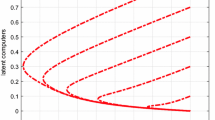Abstract
In this paper, we consider the modified epidemiological model for computer viruses (SAIR) proposed by Piqueira and Araujo (Appl Math Comput 2(213):355–360, 2009). The multi-step homotopy analysis method (MHAM) is employed to compute an approximation to the solution of the model of fractional order. The fractional derivatives are described in the Caputo sense. Figurative comparisons between the MHAM and the classical fourth-order Runge-Kutta method reveal that this method is very effective. The solutions obtained are also presented graphically.





Similar content being viewed by others
References
Abreu, E.M.: Computer virus costs reach $10.7b this year, The Washington Post, 1 Sept 2001. Available at http://www.washtech.com/news/netarch/12267-1.html
Alomari, A.K., Noorani, M.S.M., Nazar, R., Li, C.P.: Homotopy analysis method for solving fractional Lorenz system. Commun. Nonlinear Sci. Numer. Simult. 15(7), 1864–1872 (2010)
Billings, L., Spears, W.M., Schwartz, I.B.: A unified prediction of computer virus spread in connected networks. Phys. Lett. A 297, 261–266 (2002)
Cang, J., Tan, Y., Xu, H., Liao, S.: Series solutions of non-linear Riccati differential equations with fractional order. Chaos, Solitons Fractals 40(1), 1–9 (2009)
Caputo, M.: Linear models of dissipation whose Q is almost frequency independent-II. Geophys. J. Royal Astron. Soc 13(5), 529–539 (1967)
Ertürk, V.S., Odibat, Z., Momani, S.: An approximate solution of a fractional order differential equation model of human T-cell lymphotropic virus I (HTLV-I) infection of CD4\(^{+}\) T-cells. Comput. Mathe. Appl. 62, 992–1002 (2011)
Gleissner, W.: A mathematical theory for the spread of computer viruses. Comput. Secur. 8, 35–41 (1989)
Han, X., Tan, Q.: Dynamical behavior of computer virus on Internet. Appl. Mathe. Comput. 6(217), 2520–2526 (2010)
Kephart, J.O., Sorkin, G.B., Chess, D.M., White, S.R.: Fighting computer viruses. Sci. Am. 88–93 (1997)
Kephart, J.O., White, S.R.: Directed-graph epidemiological models of computer viruses. In: Proceedings of the IEEE symposium on security and privacy, pp. 343–359 (1991)
Kephart, J.O., White, S.R., Chess, D.M.: Computers and epidemiology. IEEE Spectr. 5(30), 20–26 (1993)
Kephart, J.O., White, S.R.: Measuring and modelling computer virus prevalence. IEEE computer society symposium on research in security and privacy, pp. 2–15 (1993)
Liao, S.J.: The proposed homotopy analysis technique for the solution of nonlinear problems, Ph.D. Thesis, Shanghai Jiao Tong University (1992)
Li, C.P., Deng, W.H.: Remarks on fractional derivatives. Appl. Mathe. Comput. 187, 777–784 (2007)
Lin, W.: Global existence theory and chaos control of fractional differential equations. JMAA 332, 709–726 (2007)
Miller, S., Ross, B.: An introduction to the fractional calculus and fractional differential equations. Wiley, USA (1993)
Murray, W.: The application of epidemiology to computer viruses. Comput. Secur. 7, 139–150 (1988)
Oldham, K.B., Spanier, J.: The fractional calculus. Academic Press, New York (1974)
Piqueira, J.R.C., Araujo, V.O.: A modified epidemiological model for computer viruses. Appl. Mathe. Comput. 2(213), 355–360 (2009)
Podlubny, I.: Fractional differential equations. Academic Press, New York (1999)
Rafiq, A., Rafiullah, M.: Some multi-step iterative methods for solving nonlinear equations. Comput. Mathe. Appl. 58(8), 1589–1597 (2009)
Ren, J., Yang, X., Zhu, Q., Yang, L.X., Zhang, C.: A novel computer virus model and its dynamics. Nonlinear Anal. 1(13), 376–384 (2012)
Sabatier, J., Agrawal, O.P., Tenreiro Machado, J.A.; Advances in fractional calculus; theoretical developments and applications in physics and engineering, Springer, Berlin (2007)
Wierman, J.C., Marchette, D.J.: Modeling computer virus prevalence with a susceptible-infectedsusceptible model with reintroduction. Comput. Stat. Data Anal. 1(45), 3–23 (2004)
Zurigat, M., Momani, S.: Z. odibat, A. Alawneh, The homotopy analysis method for handling systems of fractional differential equations. Appl. Mathe. Model. 34(1), 24–35 (2010)
Zurigat, M., Momani, S., Alawneh, A.: Analytical approximate solutions of systems of fractional algebraic-differential equations by homotopy analysis method. Comput. Mathe. Appl. 59(3), 1227–1235 (2010)
Author information
Authors and Affiliations
Corresponding author
Rights and permissions
About this article
Cite this article
Freihat, A.A., Zurigat, M. & Handam, A.H. The multi-step homotopy analysis method for modified epidemiological model for computer viruses. Afr. Mat. 26, 585–596 (2015). https://doi.org/10.1007/s13370-014-0230-6
Received:
Accepted:
Published:
Issue Date:
DOI: https://doi.org/10.1007/s13370-014-0230-6
Keywords
- Fractional differential equations
- Caputo fractional derivative
- Multi-step homotopy analysis
- Epidemiological model
- Computer viruses




